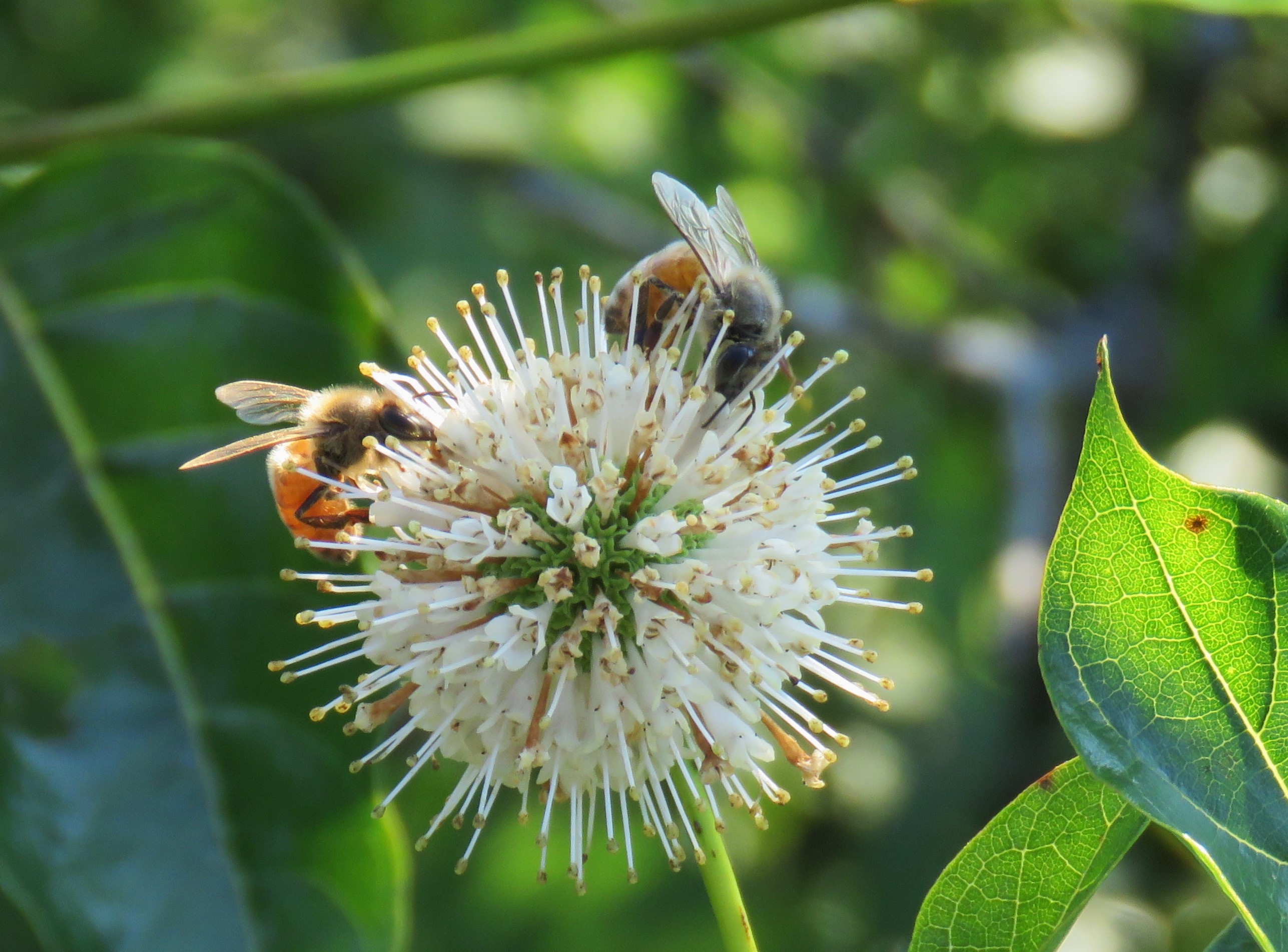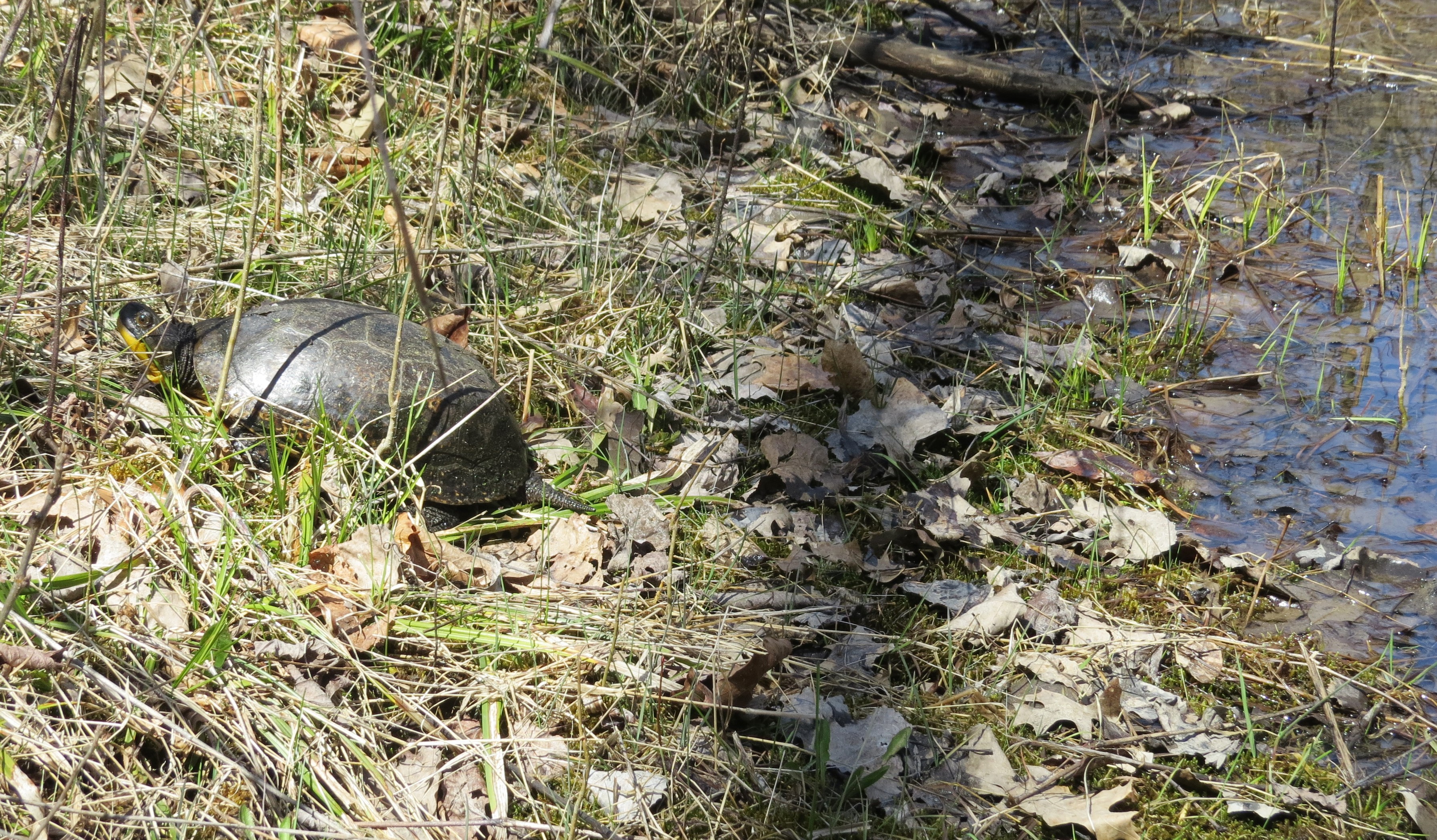Wilder Side of Oakland County
Looking for a yellow-necked timid dinosaur? I’ve got the next best thing: A Blanding’s turtle! Signs of these ancient creatures may be a slow-moving dome lumbering across the road or a mysterious shell appearing like a glistening algae coated rock at the edge of a marsh. If the turtle’s long neck is extended and the dazzling golden-yellow throat and chin are exposed, the confirmation is certain, you are viewing a Blanding’s turtle (Emydoidea blandingii); a “Species of Special Concern” in the State of Michigan. Species of special concern are generally described as:
“any species of fish or wildlife that does not meet the criteria as endangered or threatened but is particularly vulnerable and could become a threatened, endangered or extirpated species due to restricted distribution, low or declining numbers, specialized habitat needs or limits, or other factors, or is a species likely deserving of threatened or endangered status, but for which insufficient data are currently available.”
This tale of Blanding’s turtles living in our midst started back in the hills of western New York State decades ago. I first encountered one as a summer camp naturalist during my college years. In that pre-internet era, I simply knew those odd-looking turtles as, “yellow-necked turtles.” It wasn’t until I settled into my nature-embracing, trail-trekking ways on the Wilder Side of Oakland County that I discovered its true name and learned of its status. The photos of the mature Blanding’s turtle that accompany this week’s wilder side blog were captured at Rose Oaks County Park and along an abandoned trolly line that cuts through a wetland area of Brandon Township in northern Oakland County.
Blanding’s turtles are listed as threatened, endangered or species of concern in all the States and Canadian provinces where they occur. They also explain that Blanding’s turtles are vanishing as habitat destruction increases. The New York State Department of Environmental Conservation sums up the reason why this is:
“With hard shells on their tops and bottoms, turtles are instantly recognized and loved by many. However, according to the International Union for the Conservation of Nature, turtles as a group (comprised of about 320 species) are declining worldwide, faster than nearly every other vertebrate group. Threats include widespread habitat loss, fragmentation of habitats by roads and agricultural fields, and exploitation for food and the pet trade.”
Oakland County has some excellent protected pockets of prime habitat that supports Blanding’s turtles. According to the North Oakland Headwaters Land Conservancy (NOHLC), “the headwaters region is home to the Blanding’s turtle – locally common in northwest Oakland County and due to population declines, this species is of special concern in Michigan.” The NOHLC emphasizes the hazards Blanding’s turtles can face in our human-dominated environment and the importance of protecting this species of special concern:
“A female will travel through wetlands, over roads and yards, up to a kilometer looking for the perfect spot to lay her eggs. The Blanding’s turtle can take 14 to 20 years to reach sexual maturity, so any reproducing adult in the population is crucial to the continuation of the species, especially given the general vulnerability of the population.”
The NOHLC asks that you keep your eyes focused for this beautiful reptile: “The Blanding’s turtle is very easily identified by its highly domed carapace or top shell, its bright yellow throat (the color of sunshine), and the notched upper jaw which gives the illusion of a smile.” They request that if you spot one on the road, to help it on its way, while offering a bit of reassurance, “Don’t worry –they will not bite but perhaps flash you a heartfelt smile of appreciation!”
In the heat of the summer this rather nomadic species of turtle is most often seen early morning or evening; when the days really sizzle they sometimes go nocturnal. You won’t find a Blanding’s turtle in a noisy lake with jet skis or powerboats, these rather skittish and “shy” turtles inhabit quiet shallow waters with abundant aquatic vegetation. In Oakland County that habitat includes secluded marshes, chemical free rural ponds with quality shoreline vegetation and slow-moving backwaters; all which is managed by the Six Rivers Nature Conservancy, North Oakland Headwaters Land Conservancy, Southeast Michigan Land Conservancy and many of our Huron-Clinton Metroparks and Oakland County Parks along with some sections of our State Recreation Areas and State Parks under management of the Michigan Department of Natural Resources. Of critical importance is easy access to adjacent land habitat suitable for egg laying. Break walls and other obstructive landscaping practices along shorelines often prevent this from occurring.
Blanding’s turtles bear little resemblance in appearance to the other nine native species of turtles found in Michigan, with two possible exceptions, the Eastern box turtle and the Spotted turtle. The Blanding’s turtle has earned the nicknamed of the “Semi-box turtle” because its plastron (bottom shell) is hinged like that of a box turtle’s plastron, however it does not snap as tightly shut as a box turtles. Young Blanding’s turtles are also heavily spotted, creating a bit of confusion with the Spotted Turtle.
The Blanding’s turtle is considered semi-aquatic; a species that wanders back and forth from wetlands to land where it feeds in both habitats. Herpetologists agree that crayfish is a favored food, but they will also readily take frogs, snails, leeches and minnows. Fresh berries, slugs, and earthworms add to the diet on land, however land is wrought with danger, especially during the egg laying season of last month. Raccoons, skunks, coyotes and foxes are all fond of fresh turtle eggs and crossing roads to reach sand to lay eggs is often a fatal act.
A few years ago, I had the privilege of taking photographs at a Blanding’s turtle “Head Start” program at the Shiawassee National Wildlife Refuge; a cooperative effort to boost Blanding’s turtle population between the Detroit Zoological Society, the U.S. Fish and Wildlife Service and the University of Michigan Flint. The Detroit Zoo summarized the ongoing work this way on their website.
“Since 2011, the Detroit Zoological Society staff has worked with the United States Fish and Wildlife Service, the Shiawassee National Wildlife Refuge (NWR), and students at University of Michigan Flint to help conserve Blanding’s turtles which are endangered and listed as a species of Special Concern by the Michigan Department of Natural Resources. At Shiawassee NWR, few young turtles were observed in the population, and it was realized that increasing numbers of raccoons were eating turtle eggs and young. DZS and its partners initiated a “head start” program for young Blanding’s turtles. Eggs collected from nests at Shiawassee NWR are hatched at the Detroit Zoo, and young Blanding’s turtles are raised at the Zoo until they are old enough to be less susceptible to raccoon predation. More than 100 turtles have been released since 2012.”
The three photos above of the young Blanding’s turtles are all from the release site at Shiawassee and this video is from the Detroit Zoo and it explains their “head start” program.
With the egg-laying season over and the heat of the summer continuing, our local Blanding’s turtles tend to stay in or immediately adjacent of their wetlands; especially those that are dominated by shrubs such as buttonbush, an aptly named shrub with ball-like blossoms that attract honey bees. Autumn brings short-lived opportunities to view Blanding’s turtle sunning, but by the time of the first frost they have burrowed down into soft muck and that’s where they remain in a hibernation like state; until early spring when the jingle of thousands of spring peepers calling from the wetlands serves as the wake-up call to the Blanding’s turtles of the wilder side of Oakland county.
Jonathan Schechter is the Nature Education Writer for Oakland County Government and blogs weekly about nature’s way, trails, and wildlife on the Wilder Side of Oakland County.
For the latest county news and events, visit our website and follow along using #OaklandCounty on our Facebook, Twitter, Instagram, YouTube, Pinterest, and LinkedIn pages.









